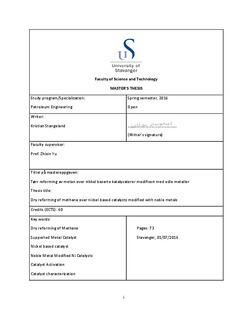| dc.description.abstract | Recently there has been renewed attention in dry reforming of methane (DRM) due to potential environmental benefits of utilizing CO2 and an increase in demand for synthesis gas. DRM refers to the chemical reaction of methane and carbon dioxide to form hydrogen and carbon monoxide which are designated as synthetic gas (syngas). Syngas is primarily produced from a catalytic steam reforming process where the resulting H2/CO product ratio is higher than the ratio required for many down-stream processes. DRM produce a syngas with a H2/CO ratio close to unity, making it an ideal feed for the Fischer-Tropsch process and highly selective syntheses of a wide range of chemicals.
The DRM utilizes CO2 as an oxidant to react methane over a heterogeneous catalyst. Group VIII metal catalysts have been extensively studied for DRM. Both noble metals (e.g. Ru, Rh, Pt, Pd) and non-noble metals (e.g. Ni, Fe, Co) have been found to be catalytically active towards this reaction. The main problem in DRM is related to catalyst deactivation due to sintering and carbon deposition. Although noble metal based catalysts are usually highly active, stable at high temperatures and experience low carbon formation, they have the drawbacks of high cost and limited availability. Hence, a more promising alternative is to incorporate small amounts of noble metals into non-noble metal catalysts.
Here, we report DRM over nickel alumina catalysts prepared by incipient wetness. The effect of modifying the catalyst with small amounts of Rh, Ru, Pt and Pd were studied. Two nickel catalysts on different alumina supports have also been investigated for comparison. The nickel loading was kept constant at 12 wt% for all the catalysts and the modified catalysts had a loading of 12 wt% Ni and 0.5 wt% noble metal. The characteristics of the catalysts were investigated by X-Ray diffraction (XRD), textural measurements, active metal dispersion and temperature-programmed reduction. Results from the XRD showed that the particle size was affected by the support and reduced by the noble metals. The textural measurement indicated similar surface area, were a slight reduction was observed for the modified catalysts. Indications from the TPR analysis suggested that characteristics of the support has a high impact on the reducibility of Ni based catalysts.
The activity and stability was investigated in a fixed-bed stainless steel reactor. The catalysts were activated at 600 oC and the DRM reactions were carried out at 700 oC at equimolar reactant feed and a gas hour space velocity of 120,000 Scm3 g-1 h-1. The stability of the catalyst was investigated for 15 hours. The activity was found to be dependent on the support and improvements were observed for the catalysts modified with Rh, Pt and Ru, while Pd showed reduced activity. In addition, the Rh modified catalyst was investigated at 650 and 600 oC to determine the effect of temperature. The deactivation rate and H2/CO ratio was found to decrease with temperature, which contradicts thermodynamic equilibrium calculations. Further research to optimize the noble metal catalyst is suggested through a higher extent of bimetallic particle control. | nb_NO |
